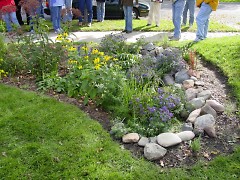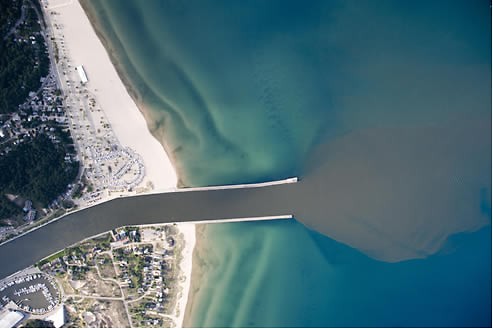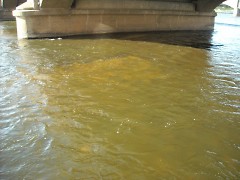"Filthy water cannot be washed."
- African Proverb
If you’re familiar with downtown Grand Rapids, you’ve likely been exposed to the deteriorating quality of the Grand River. Poor water quality prevents people from fully engaging in recreational activities because contact with the river water is potentially unsafe. Were the river clean, however, people would be more inclined to participate in these types of activities, namely rowing, boating, and canoeing, without the fear of suffering from health-related effects. The Grand River is also the host of one of the largest recreational fishing industries in the Midwest, especially for trout and salmon. Water pollution reduces the population of these fish.
While the Grand River only makes up 13% of the Lake Michigan watershed, it is still the largest contributor to the lake’s pollution. Lake Michigan is "the sole source of water treated for the Grand Rapids water system", and contaminated drinking water from this source leads to increased costs of treatment, and can be traced to adverse health effects.
Sources of pollution
The contamination of the Grand River comes from many different sources. For example, stormwater discharge carries many pollutants including oil, road chemicals, and litter directly into the river. Agricultural runoff containing dirt, debris, and pesticides runs straight into the river as well. Manure from agricultural sites is dangerous too, as it is loaded with ammonia, which reduces the amount of oxygen available to aquatic organisms. Waste from animal feeding operations and fertilizer has devastating effects on water quality as well, even if introduced in small amounts. Furthermore, clouds of sediment caused by an increased amount of soil carried into the river can suffocate fish and deteriorate the quality of other forms of aquatic life. Pharmaceuticals and personal care products are also dumped regularly into the Grand River. Water quality isn’t a new concern for the Grand Rapids area.
Sewer systems and city efforts toward a clean river
Starting in the late 1980s, Grand Rapids has undergone a transition from combined to separated sewer systems. Having a combined sewer system meant that both stormwater runoff and domestic sewage flowed through the same set of pipes to the sewage treatment plants. Although a combined system sounds good in theory because all waste is treated prior to being deposited into the Grand River, this approach was actually quite problematic because in the event of heavy rainfall, the sewage treatment plants became overwhelmed and simply discharged the stormwater containing raw sewage into the river to alleviate overflow. A separated sewer system, on the other hand, drains stormwater directly into the river preventing any potential overflow of the tanks in the treatment plants. After implementing the separated sewer system there was a 99.5% reduction in sewer overflow.
Another effort taken by the city of Grand Rapids has been the construction of rain gardens. In the past few years, Grand Rapids has engineered a variety of these water absorbing areas. Rain gardens, typically composed of native wetlands vegetation, serve to slow polluted runoff from impervious structures, such as roads, roofs, and parking lots, and allow the water to transition easily back into the earth.
Although these concerns seem to deal simply with the city of Grand Rapids, the ripples of these effects are widespread. The citizens of Grand Rapids are neither the sole source of the pollution of the Grand River, nor are they the only ones affected. Pollution from sources upstream, like Lansing for example, also negatively impacts the quality of the Grand River. Although Lansing is in the process of separating its sewer systems like those of Grand Rapids, they have yet to complete this process. As of 2007, Lansing had only reduced its combined sewage overflow by 33%, and because of this, the city was said to have been responsible for 95% of the pollution in the Grand River in the year 2006.
A great deal of positive changes can be made if individuals simply start to hold themselves accountable for their own actions regarding water pollution. The first step toward solving these issues is to gain a broader understanding of the identity of the problem. Information about water pollution is easy to find, and implementing basic strategies can go a long way in contributing toward better water quality for Grand Rapids as a whole.
The Rapidian, a program of the 501(c)3 nonprofit Community Media Center, relies on the community’s support to help cover the cost of training reporters and publishing content.
We need your help.
If each of our readers and content creators who values this community platform help support its creation and maintenance, The Rapidian can continue to educate and facilitate a conversation around issues for years to come.
Please support The Rapidian and make a contribution today.




Comments
"If you’re familiar with downtown Grand Rapids, you’ve likely been exposed to the deteriorating quality of the Grand River."
Where is the data to back up a statement like this? During what time period has the water quality deteriorated?
The data in the Lake Michigan Mass Balance Study, which your quote "While the Grand River only makes up 13% of the Lake Michigan watershed, it is still the largest contributor to the lake’s pollution" is based on was taken from 1994-2000. The document you linked to was published in August 2000. Is there more recent data available that might reflect some of the changes in sewage overflows since that time? Have their been increases or decreases in water monitoring since then? Did you interview any scientists for this article at the Annis Water Resources Institute, or activists working on these issues for WMEAC and others?
This is definitely a topic that needs to be covered, and I love seeing more hard news coverage on The Rapidian. Please continue working to give us more information that is well-sourced and accurate.
I have to agree with Joshua. I would like to see some sources to back up these claims.
Here's an example of a source: http://www.grand-rapids.mi.us/index.pl?page_id=1958
This is the Grand Rapids water quality index, which shows an overall upward trend since 1985.
Is this news, or improperly supported environmental propaganda?